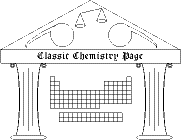Arrhenius strong electrolytes
In a paper on the dissociation of electrolytes in aqueous solution, Arrhenius presented data on a wide variety of solutes including materials we would class as non-electrolytes, strong electrolytes, and weak electrolytes. This exercise focuses on strong electrolyte salts. Arrhenius presented data on a quantity he called the activity coefficient (α) of several solutions, all containing 10. g solute in one liter of water.
| substance | formula | α
|
|---|
| sodium chloride | NaCl | 0.82
|
| potassium sulfate | K2SO4 | 0.67
|
| barium chloride | BaCl2 | 0.77
|
| cadmium sulfate | CdSO4 | 0.35
|
Arrhenius's "activity coefficient" is the apparent ratio of dissociated solute molecules to total molecules of the solute (i.e., dissociated plus undissociated). It was determined from electrical conductance measurements. A modern physical chemist would understant that Arrhenius's "activity coefficient" α is a combination of a dissociation ratio and the activity coefficient γ introduced many years later by G. N. Lewis (the activity coefficient currently taught in physical chemistry courses).
Use the Debye-Hückel limiting law to estimate the mean ionic activity coefficient γ for each solution. How would γ vary with ionic charge and molar mass for 10.g/L solutions such as those Arrhenius used? Comment on the agreement between γ and α.
Reference
Svante Arrhenius, "On the Dissociation of Substances Dissolved in Water," Zeitschrift für physikalische Chemie 1, 631-48 (1887)
Copyright 2003 by Carmen Giunta. Permission is granted to reproduce for non-commercial educational purposes.

| Back to the top of the Classic Chemistry site |